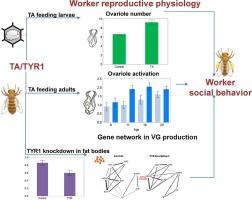Journal of Insect Physiology ( IF 2.3 ) Pub Date : 2020-08-04 , DOI: 10.1016/j.jinsphys.2020.104093 Ying Wang 1 , Gro V Amdam 2 , Bryan C Daniels 3 , Robert E Page 4

|
Honey bees (Apis mellifera) provide an excellent model for studying how complex social behavior evolves and is regulated. Social behavioral traits such as the division of labor have been mapped to specific genomic regions in quantitative trait locus (QTL) studies. However, relating genomic mapping to gene function and regulatory mechanism remains a big challenge for geneticists. In honey bee workers, division of labor is known to be regulated by reproductive physiology, but the genetic basis of this regulation remains unknown. In this case, QTL studies have identified tyramine receptor 1 (TYR1) as a candidate gene in region pln2, which is associated with multiple worker social traits and reproductive anatomy. Tyramine (TA), a neurotransmitter, regulates physiology and behavior in diverse insect species including honey bees. Here, we examine directly the effects of TYR1 and TA on worker reproductive physiology, including ovariole number, ovary function and the production of vitellogenin (VG, an egg yolk precursor). First, we used a pharmacology approach to demonstrate that TA affects ovariole number during worker larval development and increases ovary maturation during the adult stage. Second, we used a gene knockdown approach to show that TYR1 regulates vg transcription in adult workers. Finally, we estimated correlations in gene expression and propose that TYR1 may regulate vg transcription by coordinating hormonal and nutritional signals. Taken together, our results suggest TYR1 and TA play important roles in regulating worker reproductive physiology, which in turn regulates social behavior. Our study exemplifies a successful forward-genetic strategy going from QTL mapping to gene function.
中文翻译:

酪胺及其受体TYR1将行为QTL与蜜蜂工(Apis mellifera)的生殖生理联系起来。
蜜蜂(Apis mellifera)为研究复杂的社会行为如何演变和受到调控提供了一个极好的模型。在数量性状基因座(QTL)研究中,诸如分工之类的社会行为特征已映射到特定的基因组区域。然而,将基因组作图与基因功能和调控机制相关联仍然是遗传学家的一大挑战。在蜜蜂工中,劳动分工是受生殖生理调节的,但是这种调节的遗传基础仍然未知。在这种情况下,QTL研究已将酪胺受体1(TYR1)确定为pln2区的候选基因。,这与多种工人的社会特征和生殖解剖学有关。酪胺(TA)是一种神经递质,可调节包括蜜蜂在内的多种昆虫的生理和行为。在这里,我们直接检查TYR1和TA对工人生殖生理的影响,包括卵巢数,卵巢功能和卵黄蛋白原(VG,蛋黄前体)的产生。首先,我们使用药理学方法证明TA会在工人幼虫发育期间影响卵巢数目,并在成年期增加卵巢成熟。其次,我们使用基因敲低方法来显示TYR1调节成年工人的vg转录。最后,我们估计了基因表达的相关性,并提出TYR1可能调节通过协调激素和营养信号来转录vg。两者合计,我们的结果表明TYR1和TA在调节工人生殖生理中起着重要作用,而后者又调节了社会行为。我们的研究例证了从QTL定位到基因功能的成功正向遗传策略。











































 京公网安备 11010802027423号
京公网安备 11010802027423号